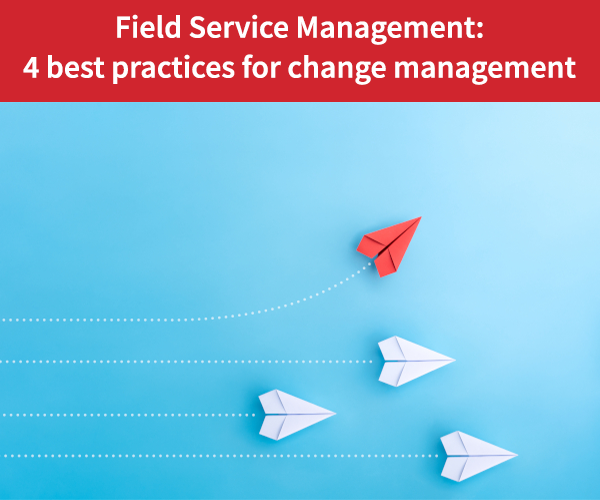
- Productivity
- Field Service Management
- Analytics
Choosing the right key performance indicators for field service management
A dashboard must include key performance indicators (KPIs) that let you monitor activities instantly, in real-time, and over longer periods. But, how do you choose the right KPIs?
If you collect too much information, it ends up telling you nothing. Your staff will quickly drown in the flow of data that’s generated by today’s real-time, content-based digital service management solutions. To ensure your executives have complete visibility of company performance, you must structure the masses of information generated to provide the essential data.
The decision-makers in your company must always know how many service calls are in progress, the reasons for service, the customers involved, and the equipment being serviced. At the same time, they must monitor the costs of service calls in relation to maintenance contracts and the potential for penalties due to delays. This requires careful monitoring of field service KPIs and field service metrics.
This 360° view is essential for company leaders to make informed decisions. The days when leaders managed by instinct are gone. Poor choices have too much impact on profitability and increase customer satisfaction, emphasizing the importance of analytics and reporting on field service KPIs within a robust field service management KPI framework.
Make dashboards user-specific
The information that should be included on a dashboard depends on who is using it. For example, dispatchers need an instant picture of what’s happening in the field. With field service KPIs that are updated in real-time, they can track service progress for an individual technician or a team. They can then use that insight to gauge the risks associated with delays or appointment cancellations and take the necessary actions to address the situation.
Monitor service guarantees
To make the dashboard user’s job easier, real-time dashboards, such as Praxedo’s Cockpit module, include pre-set field service management KPIs. These KPIs include the rate service calls are completed and whether contractual obligations such as the Guaranteed Restoration Time and the Guaranteed Response Time are being met. Field service management metrics and field service performance metrics are important in examining how to judge service quality and improvement.
The dashboard should also generate automatic alerts based on the number of missed appointments, emergency service calls, and the number of in-progress service calls that have exceeded the allotted time.
Combine real-time and historical data
Service managers don’t need real-time information. Instead, they need the ability to analyze historical service data. With this insight, they can track the performance of agencies or technicians and make decisions that help to improve the quality and cost-effectiveness of field service operations.
For example, knowing the number of service calls that were completed on the originally planned date allows service managers to gauge capacity so they can better manage daily activities and meet deadlines. To determine productivity levels, they can compare the actual travel time and amount of time it took to complete service calls to the estimated time for that type of service activity.
Use geolocation data to analyze job times
Geolocation data gives service managers the information needed to determine average time and how long field technicians are spending on jobs and to distinguish planned stops from unplanned stops as technicians complete their assignments. This data can be efficiently managed and analyzed through field service manager software, allowing for the creation of customized reports in Microsoft Word or PDF, or exported to Microsoft Excel for dynamic, graphical analysis.
Improve customer reports
You can also customize service reports with your own logo and corporate colors and provide them to customers in a personalized PDF to improve your relationship with them. This is a key feature of customizable reports in field service management, allowing for a more tailored and professional presentation of service details.
With personalized summary reports, customers can see the service activities for particular sites or pieces of equipment at at-a-glance. They can also confirm that service activities are occurring as required and that field service providers are respecting the service restoration time guarantees in their service level agreement (SLA). Moreover, the use of an electronic field service report enhances the efficiency and accuracy of documentation, ensuring that all details are recorded digitally and can be accessed instantly when needed.
Use artificial intelligence to improve decision-making
In the future, artificial intelligence field services will enhance the analysis capabilities in field service management AI software to greatly improve performance. AI can already be used for predictive maintenance and to reschedule operations on-the-fly based on field services technician availability and traffic conditions.
Looking ahead, algorithmic models will inform decision-making by using scoring systems to evaluate the profitability of a particular contract, or the risks associated with a particular customer contract.
Field service management AI is expected to be particularly useful in helping field service providers predict the future by looking into the past. For example, by analyzing historical data, you can forecast how busy you will be in the next three months and how many technicians you will need to recruit to support those activity levels.
Let AI run on autopilot
With the advances that have been made in machine learning and deep learning technologies, AI is not yet being used to replace humans. Instead, it complements human efforts, performing repetitive tasks that free up people to concentrate on higher-value tasks. Because it can analyze large volumes of data, AI gives humans early insight into the key areas where they should focus their attention.
In the future, field service management AI will take on a greater role, advancing from co-pilot to pilot, with autopilot capabilities. In autopilot mode, an intelligent system can make completely autonomous decisions, such as whether to initiate service activities or change a technician’s route by interacting with the vehicle.
Our similar articles.
-
- Software
- Productivity
- Field Service Management
- Work orders
Field service management: 4 best practices for change management
April 28, 2021 -
- Field Service Management
- Productivité
- field technicians
- service businesses
Overcoming Field Service Management Challenges in service businesses: Facing these 7 main challenges head on
June 23, 2023 -
- Field Service Management
- Field Service Software
- billing
- testimonial
- invoicing
Six companies share how Praxedo supports faster invoicing and improved billing
April 29, 2024


